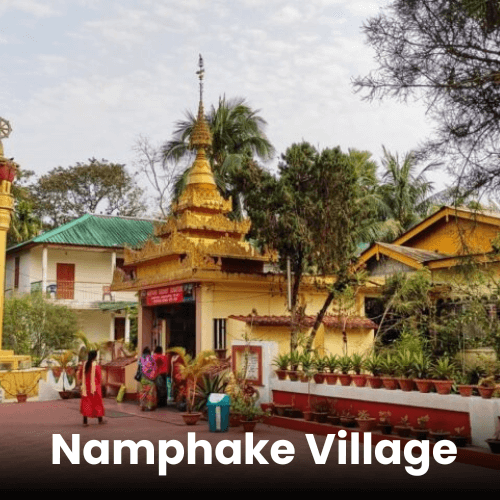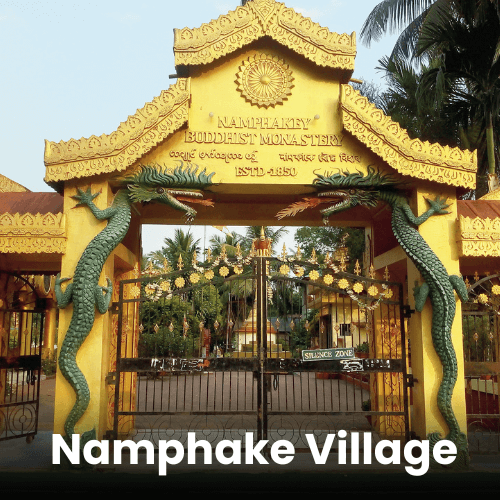Introduction
Namphake Village, nestled in Assam’s serene landscapes, is a remarkable destination preserving the ancient customs of the Tai Phake community. With around 150 families, this village stands as the largest Tai Phake settlement in Assam, offering a glimpse into a culture that has remained untouched for centuries.

A Living Heritage of the Tai Phake Community
The people of Namphake Village are followers of Buddhism, deeply rooted in their spiritual beliefs and traditions. Their language bears a striking resemblance to modern Thai, making it one of the rare linguistic connections still thriving in India. The community continues to uphold its traditional attire, rituals, and architectural styles, setting it apart as a living museum of cultural heritage.
A Historic Buddhist Monastery
One of the most captivating sites in the village is the Buddhist monastery, considered one of Assam’s most revered spiritual centers. Surrounded by lush greenery and a peaceful ambiance, the monastery is a meditation hub that attracts visitors seeking tranquility and wisdom.

Unique Architectural Marvels
The village showcases traditional Tai Phake architecture, including stilt houses designed to withstand Assam’s seasonal floods. These wooden structures, elevated on stilts, reflect a sustainable and practical way of living, passed down through generations. The village also houses other historical landmarks like the Nong Mungchiringta (Musulinda Tank), the Ashoka Pillar, and the stunning pagodas that enhance its cultural appeal.
A Royal Connection with Thailand
Namphake’s cultural ties extend beyond India, as evidenced by the visit of the Princess of Thailand in 2009. She interacted with the villagers, recognizing the similarities between the Tai Phake language and modern Thai, highlighting the deep-rooted historical bond between the two regions.
The Tai Phake Lineage and Migration
The Tai Phake people trace their ancestry back to the Mongoloid groups of Asia. Their migration to Assam in the 18th century was part of a larger movement of Tai communities across Southeast Asia. The term ‘Phake’ originates from the Tai words “Pha,” meaning wall, and “Ke,” meaning ancient, signifying their historical identity. Today, the Tai Phakes are found across Assam, Myanmar, and Thailand, maintaining their distinct cultural footprint.
A Village Without Police Intervention
What makes Namphake truly unique is its self-sufficient conflict resolution system. The village has never required police intervention, as any disputes are resolved by the community monks. This traditional justice system fosters harmony and a deep sense of mutual respect among its residents.
A Natural Approach to Healthcare
The villagers rely on herbal remedies for medical treatment rather than modern healthcare facilities. A 90-year-old resident, Jingmya Gohain, once remarked, “We eat fresh vegetables and natural food, so we rarely fall ill. If we do, our traditional healing methods are enough.” This indigenous healthcare system, passed down through generations, showcases their strong connection with nature.
Marriage and Social Structure
The Phakial community follows a patriarchal system, where sons inherit their father’s property. While marriages are generally within the community, there are no strict rules preventing inter-community unions. This balance between tradition and openness highlights the village’s progressive cultural mindset.
Tai-Phakey Eco-Tourism Initiative
To preserve their heritage and promote sustainable tourism, the community has established the Tai-Phakey Eco-Tourism Camp. Founded in 2010, this initiative aims to provide employment to local youth while offering visitors an immersive cultural experience. The camp includes activities such as ethnic village tours, trekking, bird watching, and library access. It also provides cozy cottages, allowing guests to experience authentic Tai Phake hospitality.
A Destination of Cultural and Natural Harmony
Namphake Village is not just a historical site but a thriving cultural ecosystem where traditions blend seamlessly with nature. Whether it is the serene Buddhist monastery, the unique architectural styles, or the untouched traditions of the Tai Phake people, this village remains an invaluable part of Assam’s rich heritage.
FAQ’s:
Where is Namphake Village located?
Namphake Village is situated in the Naharkatiya region of Assam, near the Buridihing River. It is about 6 kilometers from Naharkatiya town and around 37 kilometers from Dibrugarh.
What are the traditional houses in Namphake Village like?
The villagers live in stilt houses, a traditional architectural style designed to withstand floods. These houses are made of wood and bamboo, reflecting the sustainable lifestyle of the Tai Phake people.
Do the villagers use modern healthcare facilities?
Most villagers rely on herbal medicines and traditional healing methods instead of modern medical treatments. They believe in a natural lifestyle and consume fresh organic food, which helps them stay healthy.
What is the Tai-Phakey Eco-Tourism Camp?
The Tai-Phakey Eco-Tourism Camp is a community-run initiative that promotes cultural and nature-based tourism. Visitors can experience Tai Phake traditions, enjoy local food, go birdwatching, and explore the surrounding rainforest.
Has Namphake Village received international recognition?
Yes, in 2009, the Princess of Thailand visited Namphake Village and interacted with the locals. She was amazed at how closely their language and culture resemble modern Thai, reinforcing the village’s historical significance.












